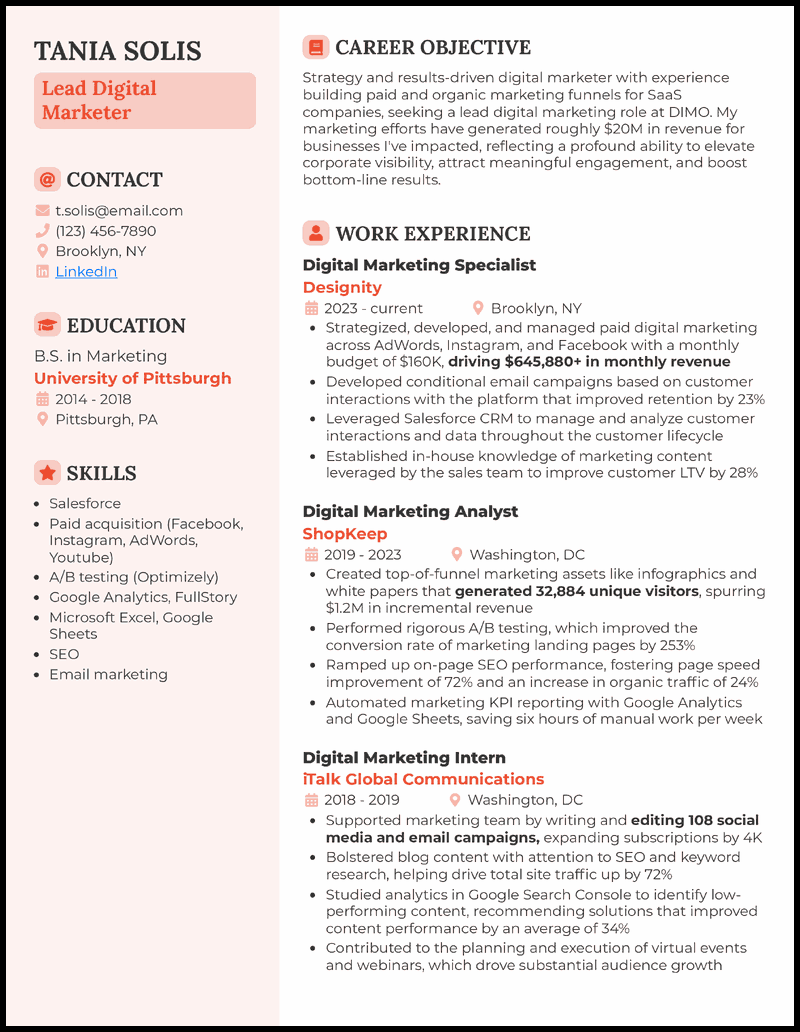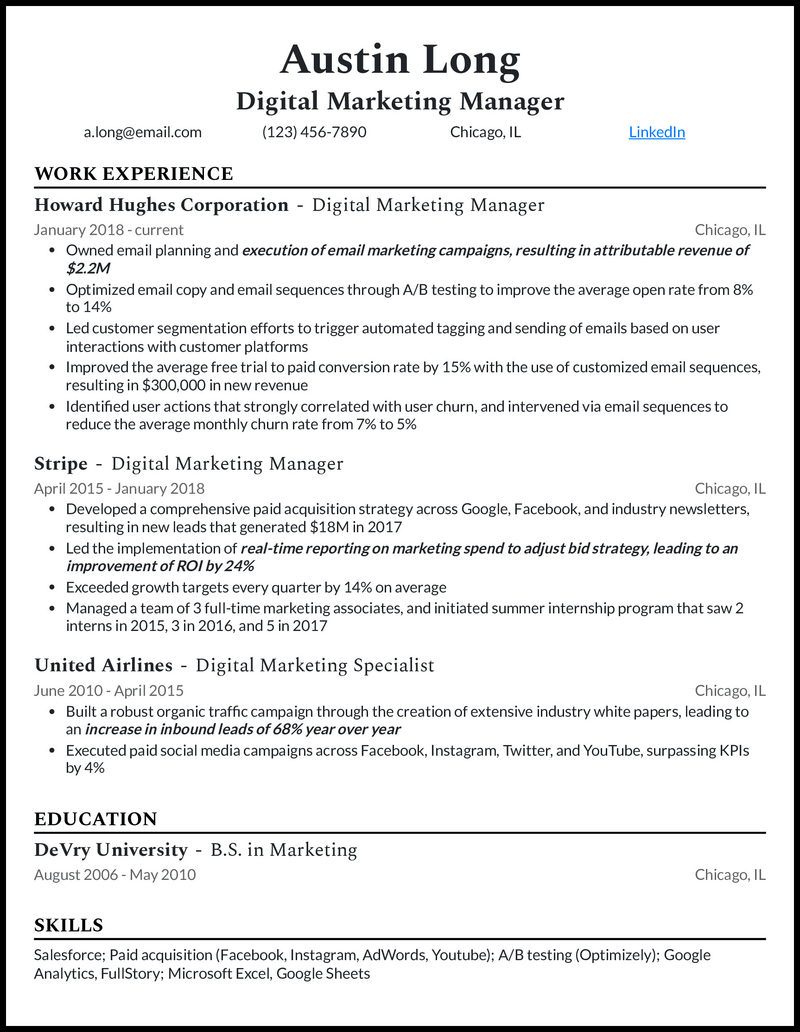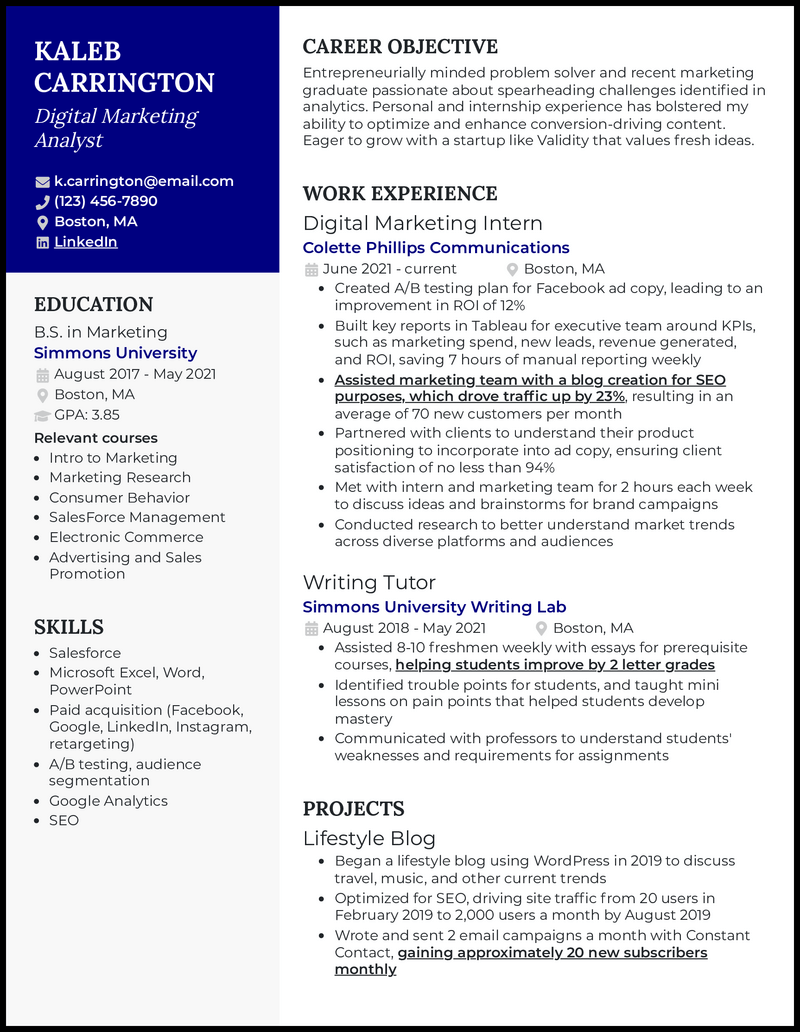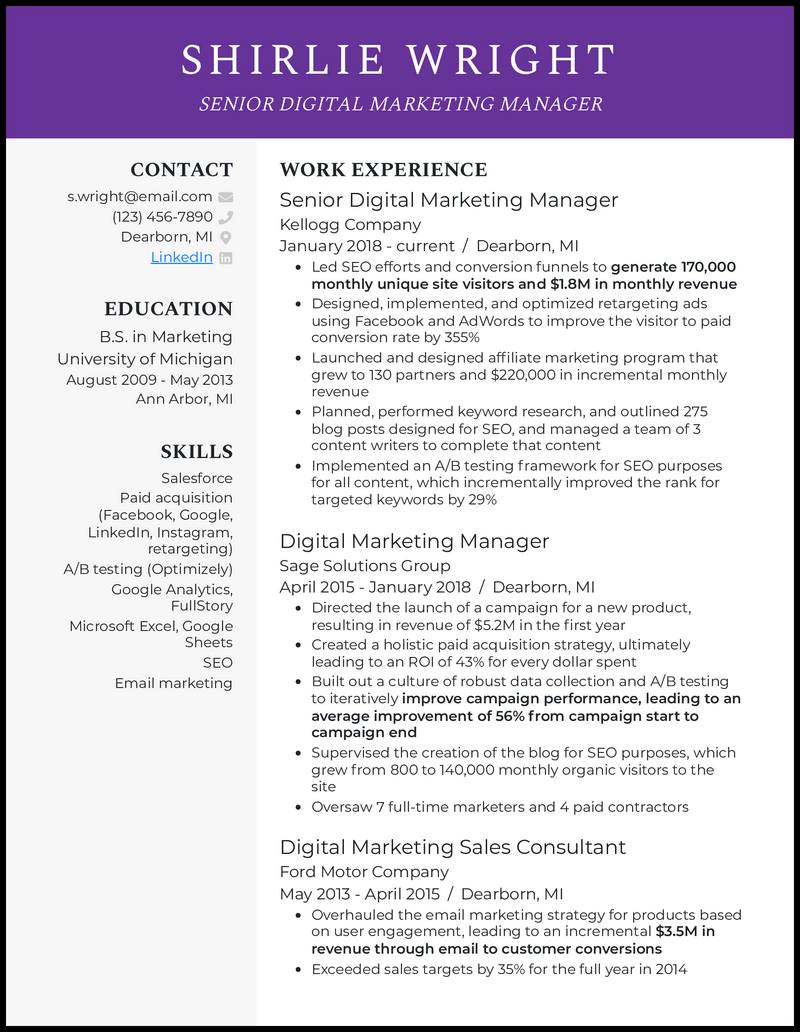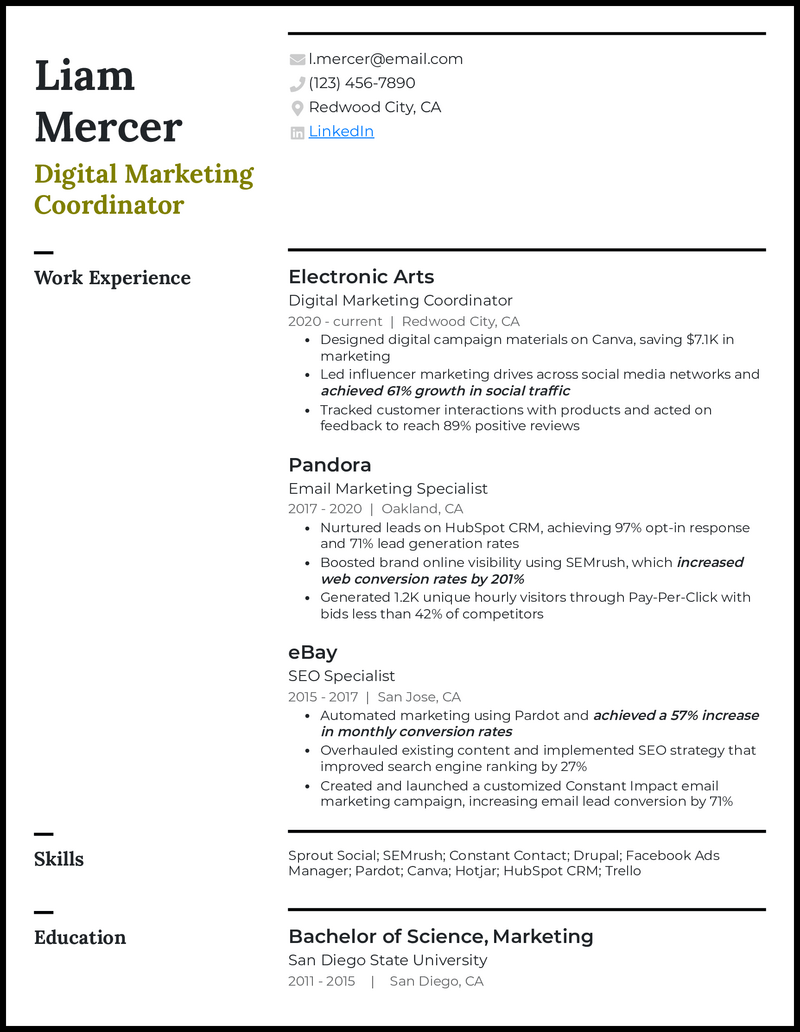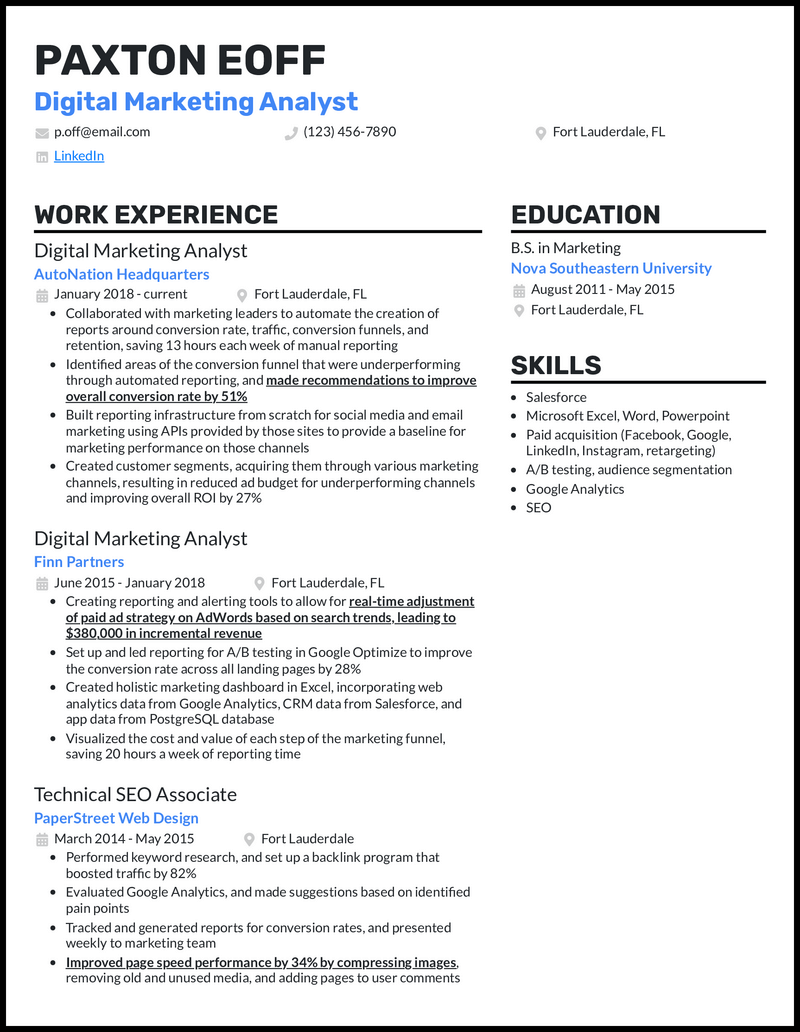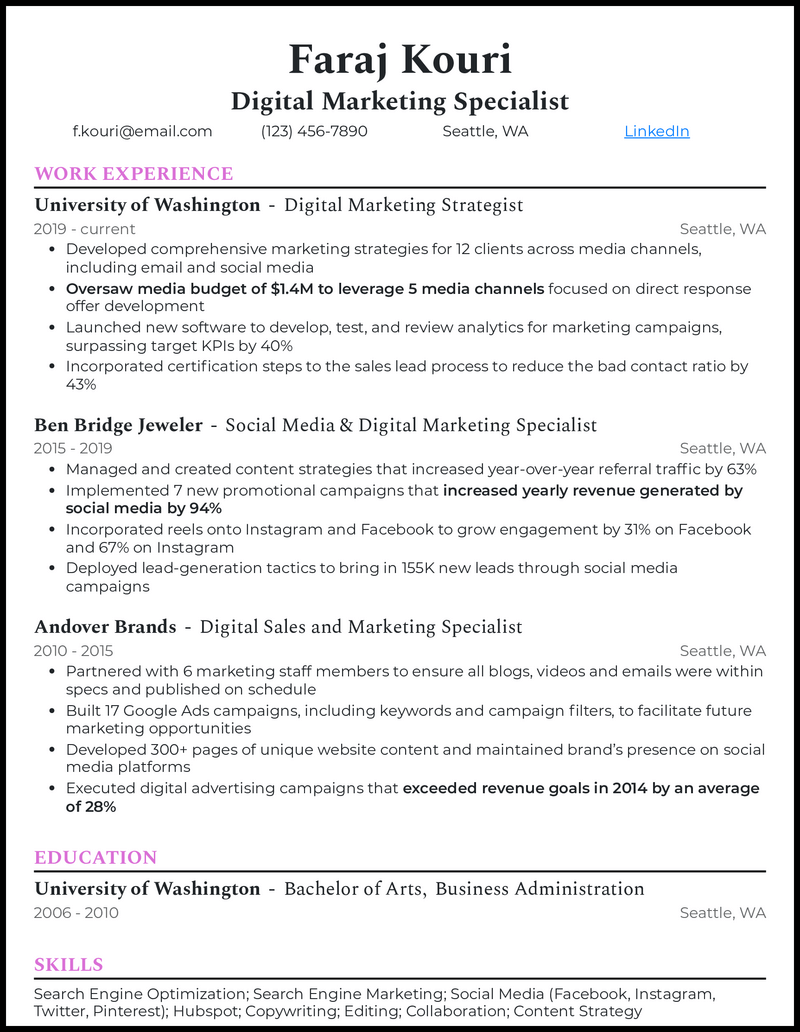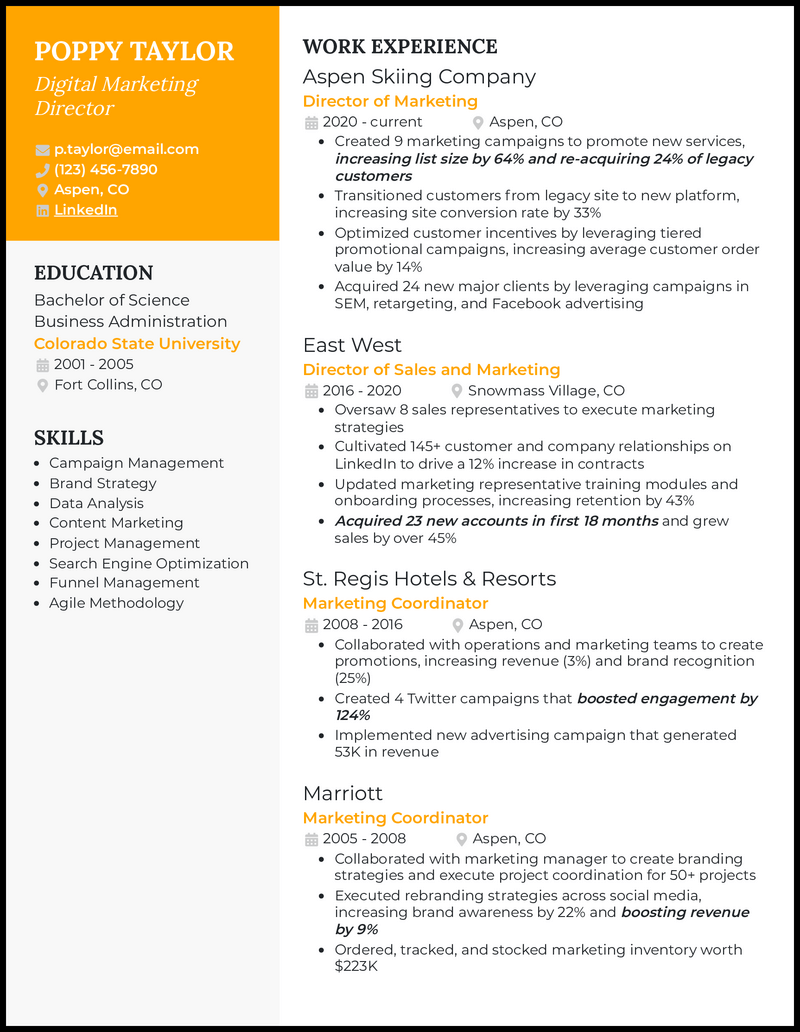You’ve heard the saying that the hardest part is getting started. When it’s time to write your digital marketing resume or create a cover letter, staring at a blank page is undoubtedly the worst and most intimidating part of the process.
To help alleviate this stress, we’ve researched what hiring managers want to see on digital marketing resumes. Now, we’re sharing our findings with you so you can build a resume with confidence.
These digital marketing resume samples have helped digital marketers get interviews at companies like Slack and Stripe, so they’re a great place to get inspiration for your own resume. No matter what digital marketing role you’re striving for, use our writing tips and templates to help you land more interviews (and get the job) in 2025!
Be ATS-friendly
- Resume screeners can be mean and directly dismiss your entire application if you don’t include the job description details.
- Before writing your digital marketing resume, make sure to read the job post carefully and note down important points like being skilled in HubSpot, a degree in marketing, or an AMA Professional Certified Marketer certificate.
- Next, sprinkle these throughout your entire resume and avoid flaunting complicated designs such as pie charts or graphs and acronyms. Keep your language simple and to the point.
Format the education section
- If the job you’re applying to clearly states education as a minimum requirement, don’t forget to include your Bachelor’s in Marketing or any relevant degree.
- Also, it’s best to place your degree where employers can easily see it. Using a resume builder will help you make any placement arrangements if you want to include multiple degrees.
- Remember the courses you undertook while in college? Add them in! Topics like Consumer Behavior and Social Media Strategy are key to spreading the word about any brand!
Eliminate vagueness
- From looking up customer records in Salesforce to creating social media posts using Hootsuite, digital marketers use a variety of software to get their daily tasks done.
- It’s a great idea to include such skills that you’re proficient with, however, not providing context can make employers question whether you’re being truthful or not.
- Instead of simply listing these skills down, mention them in your work experience bullet points and how you’ve used them. For instance, “Automated daily social media posting using Hootsuite, helping the marketing team complete 2 extra tasks every day.”
Use a career summary
- Candidates who have a good amount of experience in digital marketing can leverage a career summary to write about their expertise and greatest achievements.
- Don’t overdo this though. Keep things short and simple. A simple four-line summary will be more than enough to help you add the skills you’ve mastered over the years and any significant impacts you’ve made with marketing campaigns.
- Here’s an example as a head start: Experienced digital marketer with 11 years of experience and high proficiency in HubSpot seeking a role at your company…”
Give projects the spotlight
- For candidates with no experience in working for digital marketing agencies, it’s best to include projects that show your skills to create campaigns and attract an audience.
- Think about your university days and recall any projects where you worked to spread the word about a cause, event, or competition. But, remember to write how you used specific skills to ideate and execute marketing tasks.
- Try something like, “Used Buffer to create captivating social media posts and increase the charity’s online traffic by 28%.”
Show certificates
- You may not always require a certificate in a marketing resume, but if you’ve got the space then including one won’t hurt your chances of getting hired.
- A good trick is to include certificates that match exactly what the job description requires.
- So, if the job is looking for candidates well-versed in HubSpot, add a HubSpot Content Marketing Certification. Similarly, if they need someone to improve their social media presence, try including the Meta Blueprint Certification to prove your expertise in Instagram and Facebook simultaneously.
Deploy action verbs
- Though sometimes overlooked, using action words in your digital marketing assistant resume ranks among the most effective ways to catch the recruiter’s eye and win their favor.
- So, action verbs (cue developed, led, managed, directed, guided, and spearheaded) make it easier for hiring managers to grasp your contributions in past roles and potential impact in the open one. Any caveats? Yes — recycling the same word too often will rub recruiters the wrong way, begging the need to mix up those verbs.
Start with a career objective
- Your VP digital marketing resume could really benefit from a customized resume objective that lets the hiring manager in on your intent for the role while accenting the unique aspects that make you the best person for the job.
- The top of your resume (either in the header or the sidebar) is the prime spot for your career objective statement, with a hint of relevant experiences like VP of digital marketing, CMO, and digital marketing manager driving additional clout. And remember, brevity is non-negotiable here; anything more than a brief paragraph of two or three sentences is a cardinal sin that could haunt your attempt at making a great first impression.
Showcase remarkable wins
- In digital marketing, winning boils down to your ability to capture your audience’s attention. Guess what? The same goes for job hunting. On your digital marketing associate resume, strategically bolding a couple of your most remarkable wins can command attention like a well-placed CTA on a landing page.
- You noticed bits like “…driving 9K additional interactions…”, “…surged article reach by 14,338 clicks…” and “…analyzed 3,649 survey responses…” in Lucan’s masterpiece as well, right? Expect them to catch the hiring manager’s eye in the same manner.
Display your skills in action
- For a self-taught digital marketing resume that will help you land your dream job, zero in on your initiative, an in-demand skill that shows off your drive and how serious you are about leveling up your career.
- Using the right action words (think delivered, secured, chaired and generated, etc.) can get the job done here. To sweeten the pot, go ahead and put some numbers to those achievements. “Sparked community involvement by launching a UGC initiative, collecting 1,460+ unique photos for city promotion” is a good example.
Flaunt educational background
- Your digital marketing consultant resume should highlight your commitment to your career. How do you do that, though? A smart move is to spotlight your job-relevant educational credentials.
- Let’s say you have a degree in Marketing; let it shine in your resume’s education section. Of course, you need to do more than drop the degree name—add your alma mater, the institution’s location, and the graduation date or dates attended in that part, too.
Show passion for the role
- Yes, personalizing your resume could really sweep hiring managers off their feet. However, using the first-person pronoun (I) in your freelance digital marketing resume is not it—that’s a deal breaker that could ruin your chances.
- Using the first-person narrative without “I” adds a professional touch to the piece while keeping things brief (seeing that you don’t spill to a second page). Plus, it sidesteps repetition, a typical risk when that pronoun takes the lead in every sentence in your work history.
Display career journey
- Digital marketing is often trying out new things at different agencies so ensure that your resume outlines how you’ve made it to your current level.
- To begin, use a reverse-chronological resume format to add your three best work experiences. Starting from the top, add your most recent roles and go back in time as you keep going lower.
- Not sure which ones to include? Pick the ones that align best with the job. For a marketing manager role, try something like (from top to bottom) Brand Manager, Marketing Specialist, and Social Media Coordinator.
Update your skills
- You’ve probably used a bunch of marketing software throughout your career, but what really matters are the ones that companies rely on today.
- Overwhelming employers with a skill set that doesn’t align with the job will get you nowhere, so, check out the job description and include all the skills they’ve listed that you’re good at.
- From Google Analytics, Mailchimp, and ActiveCampaign, to modern automation platforms like Klaviyo, be as specific and relevant as the job needs you to be.
Quantify more
- Digital marketing is all about getting results. If your efforts don’t help companies meet a good ROI or make any impact, they’re not worth mentioning.
- Take a good look at your work experience bullet points and identify as many areas as you can to quantify impacts such as growing traffic or improving email click-through rates.
- Use this for inspiration: Launched an SEO campaign targeting high-tail keywords, which attracted 11,000 unique visitors every month on the company’s blog page.”
Use pre-built templates
- An easy-to-make mistake is not using the right resume format. Sure, employers want to see your best marketing results, but at the same time, they don’t want to go through walls of text with no design.
- Avoid cramping every work experience under a small design and leverage pre-built templates that offer rich space for longer bullet points and equally space out each job.
- Feeling extra creative? Try using an AI-powered resume builder to use different fonts, spacing options, and color tones at your disposal.
Fit into company culture
- Before you send in your resume, take a minute to research the kind of company you’re trying to get into. What is the company’s culture like? Strictly corporate? Or maybe a team that’s entirely informal?
- Try to align your language with their atmosphere. If they’re formal, keep your sentences concise and start sentences with strong action words like Improved or Boosted.
- For informal companies, you can take a breather and use more fleshed-out points and include any personal hobbies to match their wavelength.
Related resume guides
Writing Your Digital Marketing Resume
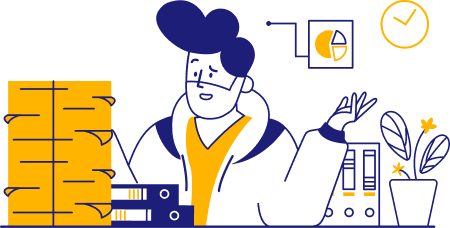
Your digital marketing resume serves as your first impression to employers, which means you want it to be formatted correctly for prospective employers. Correct resume formatting ensures your digital marketing resume is readable, logical, and professional.
The most popular formats for resumes are the reverse-chronological, functional, and combination/hybrid formats.
Reverse-chronological, functional, and combination formats
- Reverse-chronological: This format is the most popular and the most preferred by employers. (It’s the tried and true resume standard!) It’s the best format if you have a strong work history with no employment gaps. It’s also the best option to showcase experience because it provides a clear timeline of your career progression. In this format, your work history and experience are listed in reverse-chronological order, starting with your most recent position.
- Functional: The functional format is usually used by individuals who have gaps in their work history, have changed careers a few times, or have little relevant experience. Your skills and abilities are listed first in this format instead of your work history.
- Combination: This format mixes the reverse-chronological and functional formats to place equal emphasis on skills and work history.
It’s difficult to know which format to choose when writing your resume. If you’re unsure which to choose, it’s best to use the reverse-chronological format because it’s easy to read with a logical flow. Plus, it’s the unofficial standard for resumes, so employers (and the ATS) know how to scan it quickly.

Digital marketing resume header
You already know the importance of marketing, so when it comes to your resume header, this is where you should display relevant information prominently. It should be located at the top of your digital marketing resume.
The font you use for your name should be larger than that of the rest of the resume, and you should also include the job title (slightly smaller than your name) of the role you’re seeking.
Underneath your title and name, you need to put your contact information, starting with your email address. Avoid using the email you created in high school—if the only handle you have is missfluffypants@email.com, it takes just a few minutes for a tech-savvy individual such as yourself to set up a new Gmail account with a professional handle.
After your email, add your phone number in case employers wish to contact you directly. Then it’s up to you whether you list your location (just your city and state) and social media links. Your location may be important to alert employers to your availability for an in-person interview, but you can leave it out if you’re out of state.
If you have a LinkedIn profile or other professional websites, list the URLs in your contact header. This is a good way to showcase your skills and experience to employers. (Plus, many employers require your LinkedIn profile on your application.)

What you need to know about the ATS
When you’re applying for a digital marketing position, it’s important to know about applicant tracking systems, also known as the ATS. Employers use the ATS to scan resumes and filter through potential candidates. If your resume isn’t formatted correctly or lacks keywords, it will be filtered out, and you won’t be considered for the position.
If you’re using a Google Docs resume template or a Word resume template, consider certain formatting elements to beat the ATS:
- Use standard one-inch margins on all sides of your resume; reduce it by a half-inch if needed. This makes it easier for employers to read, and your digital marketing resume won’t look cramped.
- Choose a simple, standard font, such as Arial, Calibri, or Times New Roman. Don’t use a script or ornamental font because it will be difficult to read.
- Use a font size of 10-12 points for the body of your resume. Section headers should be larger at 14-16 points.
- Organize your resume logically with the most important information at the top. The easiest way to do this is to list your experience and education in reverse-chronological order. This format will ensure the reader will see your most recent experience and education first.

Your digital marketing resume writing guide
Though you’re a pro when it comes to marketing, it’s daunting to try and market yourself with only a single page. Building a resume is never going to be easy, but it can be a lot easier when you take it section by section with a resume maker.
Important factors in building your digital marketing resume:
- Resume objectives and summaries
- Work experience
- Digital marketing skills
- Education and certifications
- Projects, interests, and hobbies

Do you need a resume objective or summary?
A resume objective is a short statement explaining what you’re looking for in a job and what you can offer. A resume summary is a longer, more detailed explanation of your aggregated skills, experience, and accomplishments.
You won’t need to use either one for your digital marketing resume most of the time. For an objective or summary to work, it must be specific. Skip this section altogether if you can’t commit to customizing your objective/summary to each job for which you apply.
Think you might want to include an objective or summary anyway? Here’s when you should consider using an objective:
- You’re changing careers
- You do not have much experience
And here’s when a summary might be the key to winning the day:
- You have at least 10+ years of experience
- You want to highlight an accomplished work history
Excellent objective
Analytically-minded digital marketing graduate with a 12-week internship experience in social media management, analytics implementation, email acquisition, and web analytics. Eager to develop my skills under expert leadership within a team setting, where I can contribute to paid search and social media campaigns for Ritchie Bros.
Why this objective works
This objective clearly states the company and the specific role the job candidate is seeking, pulling keywords, such as “paid search” and “social media campaigns” from the marketing job description. The job seeker demonstrates why they’re a good fit for this role by beginning with appropriate background information and skills.
Excellent summary
Seasoned and goal-oriented digital marketer with 12 years of experience managing and executing successful marketing campaigns across multiple channels, including online, offline, and mobile. I have a proven track record of increasing website traffic and conversions by more than 25% through SEO/SEM, social media, email marketing, and content strategy. Looking forward to joining a tech startup like Steadily, where I can accelerate the growth of the company through a decade-plus of experience and mentorship of junior digital marketers.
Why this summary works
This summary highlights 12 years of experience in digital marketing and explains why the candidate is suited for the job with quantifiable metrics aggregated across total work history. The summary also includes keywords like conversions and SEO from the job description.
Digital Marketing Work Experience

When writing the bullet points for your work history, think about relevant experience. Three to four job experiences are the sweet spot, but if you have fewer than two, we have some tricks that will improve your digital marketing resume. If you’ve had many jobs, keep them handy on a master resume, but don’t list every position; just include the most relevant ones that fit the job description.
Utilizing action verbs to demonstrate achievements
When writing work experience in a bulleted list, active verbs are the best way to describe your expertise and show your work in action. As a digital marketer, the following active verbs could serve you well:
- Strategized
- Launched
- Created
- Automated
- Optimized
- Led
- Improved
- Exceeded
- Coordinated
- Executed
Avoid using passive language like “was responsible for.” Similarly, personal pronouns (I, me, my) are space wasters.
The following three work experience bullet points are a solid start but still lacking:
- I managed a team of 10 employees
- Directed all online marketing campaigns
- Collaborated with management to enhance automation
To be fair, these bullet points have some solid information we can leverage, but they’re still too vague. They fail to demonstrate how your duties gave way to achievement.
With active language, role specifics, and quantifiable metrics, these become much stronger bullet points:
- Managed a team of 8 junior digital marketers to increase online sales conversions by 10% within 3 months
- Directed an email campaign that increased website traffic by 22% in 2020
- Collaborated with marketing leaders to automate the creation of reports around conversion rate, traffic, conversion funnels, and retention, saving 13 hours of manual reporting each week
Does every bullet point need some sort of metric or quantifier? No. However, it should be a goal to shoot for.

Leverage data and metrics to showcase impact
Let’s dive further into metrics. Metrics are important because they allow the reader to determine your effectiveness in your role and if you met expectations. These numbers must demonstrate how you impacted the company directly or indirectly.
So, when listing work history, include metrics that support your experience. Aim to have metrics in 60 percent or more of your bullet points, so you’ll be ahead of your competition. Metrics can be derived from several areas:
- SEO and site traffic performance
- Marketing campaign results
- Conversion rate improvements
For example, your job experience bullet points could look something like tho which you apply. If you’d rather not take the time to tailor it to each position, you’re better off leaving this section out.
- Led SEO efforts and conversion funnels to generate 170K unique monthly visitors and $1.8M in monthly revenue
- Tracked email and social campaigns and identified areas to optimize in SEO, design, and content, resulting in an average of 7% more customers per month
- Created reporting around paid marketing funnels and leveraged this to improve the conversion rate by 210% incrementally

Strike a balance between hard and soft digital marketing skills
There are two kinds of skills to include on your resume: hard and soft skills.
Hard skills are technical abilities specific to the job, like A/B testing or Google Analytics. Soft skills are more general traits that employers appreciate across most jobs, like teamwork or communication. While soft skills are important, your digital marketing resume should contain mostly hard skills.
Hard skills might include:
- Social media advertising
- Brand awareness
- Google Analytics
- Email campaigns
- Lead generation
- Conversion funnels
- SEO/SEM
- HubSpot

Soft skills (again, not the focus) might include:
- Interpersonal communication
- Self-motivated
- Detail-oriented
These are ordinary hard and soft skills used in digital marketing, but there are many more for which an employer may be looking. Pay close attention to the keywords listed in the marketing job description, then use that to tailor your skills section with six to ten relevant keywords.

Enhance your resume with education and certifications certifications
At minimum, you’ll need a bachelor’s degree to begin your career in digital marketing. This means you can skip listing your high school diploma if you’ve got a degree. If you have a master’s degree, include your bachelor’s as well and list them in reverse-chronological order.
Especially once you’ve gotten some years under your belt, you don’t need to include anything fancy. Just list the basics:
- The name of your college or university
- Your degree
- Your major
- How many years you attended (it’s fine just to list the graduation year)
If you want to show off further training, you can add a dedicated certifications section. Certifications don’t take the place of a degree, but some employers may request certain certs from you. There’s a world of certifications available for you to pursue through Google, Coursera, Facebook, YouTube, and many more.
Certs range in experience level, price, and requirements. If you do have a cert(s) or plan to pursue one, this sort of thing is simple to include. You can briefly list it in the sidebar or at the bottom of your resume.

Do you need to add projects, interests, or hobbies?
Most resumes don’t include projects, but sometimes they can be helpful to give the recruiter more information about you, especially if you’re short on previous job experience.
If you’re including projects on your digital marketing resume, treat projects as you would your work experience section by listing three to six bullet points under each. Like your work experience bullet points, your project bullet points will demonstrate your role in the project and the positive outcomes. Metrics are encouraged here, too.
Projects could range from anything to developing a social media campaign for a small business or tinkering with a personal blog and optimizing SEO performance.
Adding an interests and hobbies section isn’t the same as a projects section. Consider including this section if the job description references the importance of a good company cultural fit or if they seem pretty casual. Even if the company is casual, it’s not okay to list any ol’ thing. Binge-watching Netflix and napping on the weekends are not the kinds of things you want to advertise to potential employers (but hey, we understand the importance of a good nap).
Instead, opt for interests and hobbies for which you can intelligently demonstrate relevance to the job if asked during an interview.
For example, as a digital marketer, experimenting with French cuisine demonstrates that you’re a self-starter who is creative and doesn’t mind trying new things. As another example, playing rugby throughout college shows that you’re well-rounded and can balance your time well.
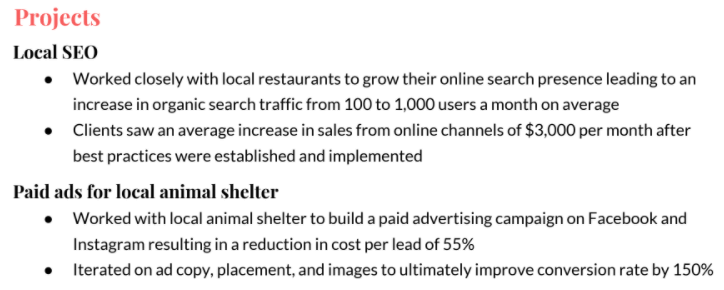

Tailoring your digital marketing resume to each job
If you’ve made it this far, you’re nearly there, just hang in there for this critical piece of advice. Tailor your digital marketing resume to each job you apply for.
Tailoring your resume is easier than you think. You only need to slightly adjust the following sections:
- Work experience bullet points
- Skills
- Objective/summary (if you included one)
We’ve discussed the importance of reading the job description carefully and including the keywords mentioned. Don’t do a copy/paste job, and be honest about your abilities. Include keywords strategically to show your employer that you have the skills and experience needed.

Ensure your resume is flawless
Lastly, don’t let your resume fall into anyone’s hands until it’s perfectly polished and error-free. Let your resume rest overnight before you return for a final look. For best results, check your resume multiple times and even better, have a friend or trusted colleague look it over, too!

Common mistakes to avoid in your digital marketing resume
In addition to everything you’ve learned, avoid these mistakes when creating your resume to ensure better chances of getting a job:
- Use of buzzwords for the sake of it- using words like “Results-oriented”, “growth-hacker”, and “forward thinker” without data to back it up reflects bad on you.
- Ignoring ATS optimization – hiring bots will not have an easy time parsing your application if it doesn’t contain keywords from the job description.
- Including irrelevant skills – skills that don’t align with the specific role you’re applying for have no place in your piece
- Exceeding resume length – anything above a page is considered too long. Only include relevant info.

Land your digital marketing job
At last, you made it! Maybe you still have to finishing writing your resume, but we’re confident that your resume will be better with these tried and tested tips.
Just remember:
- Your resume format matters greatly, and the reverse-chronological format is your best friend.
- Use your contact header to market yourself quickly by placing it at the top of your document.
- Plan to beat the ATS by including keywords in the job description.
- An objective or summary is optional, but if you want to include one, tailor it to the job.
- Use active language and metrics in your work experience bullet points to leverage your abilities.
- Job-specific technical skills, particularly those listed in the job description, hold more weight than soft skills.
- List your education in reverse-chronological order.
- Projects, interests, and hobbies might be appropriate to add if you’re short on experience.
- Customize your resume for every job application.
- Never submit a resume unless it’s error-free, so check it multiple times!
There you have it! With these tips, you’re one step closer to landing your dream digital marketing job. Now, you can become a professional resume builder and work on your digital marketing cover letter, so you can get more interviews.
We’re cheering you on!





